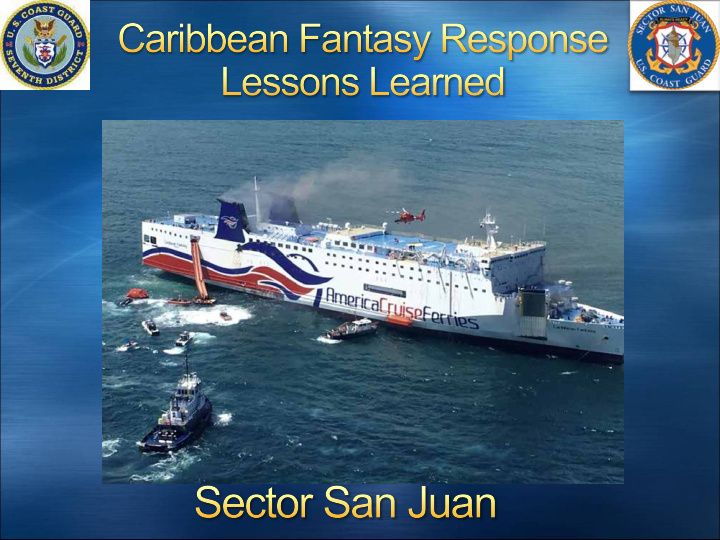



Day 1
Day 1
Staging area Buses & Ambulances In Use
Day 1 Day 2
Days 2 & 3
Day 4
Day 4
Cumulative results (as of 211900ZAUG2016) � Rescued 511 passengers and crew; 5 dogs. � Mobilized 20+ federal, commonwealth, local, and industry partners for coordinated ICS response to ensure safety and minimize environmental impacts. � Coordinated salvage effort to refloat, ensure the stability of, and safely conduct dead ship tow of 614-ft, 28,000 ton vessel, followed by the extinguishing and overhaul of the engine room fire.
Quick MR O activation & partnering saved 511 lives + R apid implementation of IC S / establishment of IC P + Timely R F F / Activation of C G DS F and S ME ’s + E xercising MR O more frequently than requirements + Maintaining a P axVsl S pecialist at certain S ectors w/ HC P Vs + Immediate MTS R U T eam/C AR T population provided transparency and helped address questions before additional work was generated.
Δ Insufficient Interagency communication procedures and capabilities Δ Additional MRO plan familiarity needed Δ Maintaining ICS structure until threat of potential pollution was successfully mitigated Δ Don’t underestimate social media
Successes + Timely R F F /Activation of DS F & S ME ’s: S trike T eam, IMA T , S E R T engineers, Doc support. + E S D support was rapid and efficient + E xcellent engagement from trustees Challenges Δ P ersonnel: Need more qualified IC S personnel & lacked pre-designated bilingual agency reps Δ F acilities: Insufficient space for Incident C ommand P ost & J oint Information C enter Δ Processes/procedures: proficiency w/ Incident Management S oftware S ystem
S uccesses + R apid initial notifications and MR O Plan activation and AC P + Immediate S ector wide response -initial phases and IC P S tand-up + Immediate designation of on-scene commander C hallenges Δ Limited initial situational awareness and communication on-scene Δ Management of the amount of information flowing into the C C Δ Language Barriers and need for S panish speakers in the S C C and Pier 6
S uccesses + Quantities, diverse capabilities, and response times of assets were critical to success C hallenges Δ Insufficient Interagency communication procedures and capabilities Δ On-scene air control/air boss not initially designated Δ E stablish T emp F light R estrictions earlier Δ Difficulty accounting for numbers on the ship. Verification of clear ship.
S uccesses + Landing site and R eception C enter designated in MR O plan were validated + C oast Guard representation at on-scene mobile command post and landing site was critical C hallenges Δ Accountability was difficult to perform Δ C ommsbetween Landing S ite & C omC en were difficult to establish due to lack of communication equipment Δ Need to identify/train personnel for Advance T eam to landing site
Successes + 24/7 “E yes on” achieved via F R C + Use of cutter small boat was optimal + C ommscheck-ins w/ salvage assets Challenges Δ Provide upfront expectations for S afety Z one enforcement. UoFexpectations, etc. Δ Identify type and make of vessels making up the salvage crew and provide a list to S afety Z one assets Δ C onfusion differentiating crewmembers of salvage skiff from locals unaware of the safety zone Δ Helo C heck-in
Recommend
More recommend